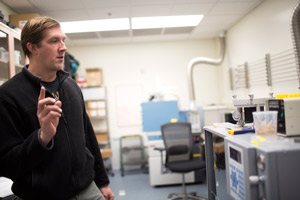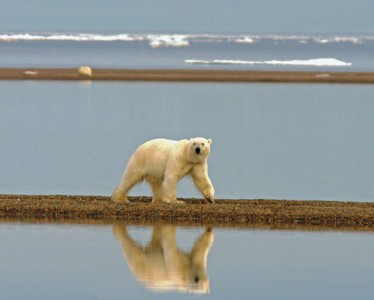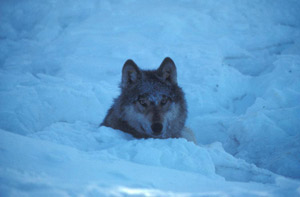Nitrogen is a key to unlocking nature's back stories
by Kathleen McCoy |
[A version of this story was published May 19 in the Anchorage Daily News. Watch a video of Matt Rogers working in the Stable Isotope Lab at UAA, called 'How to Process an Isotope," created by and featured on the Frontier Scientists website.]
Maybe high school chemistry class was the last time you heard anyone mention the periodic table of elements. It lists 118 building blocks for everything in nature. Nitrogen is one of them.

Matt Rogers runs nitrogen samples through mass spectrometers in the ENRI stable isotope lab to determine diets of Alaska wild animals or what nutrients are nourishing plants in Alaska soils.
If you are Matt Rogers, manager of the stable isotope lab for the Environment and Natural Resource Institute at UAA, nitrogen is a reliable key for unlocking nature's backstories. Take a tiny piece of animal tissue or a few plant leaves, some water or some dirt, and with the help of high-end technology, he can detail the food web story behind any of it.
Was that polar bear eating ringed seal or bowhead whale leftovers? How much of that wolf's diet was caribou and how much was salmon? Exactly what nutrients were available in the soil to grow that shrub?
I asked if his job was like reverse-engineering a recipe-working backwards to figure out everything that went into a chocolate chip cookie. He humored me with a yes, but said instead of just identifying routine ingredients like sugar, flour and eggs, his tools can tell exactly what the chicken that laid the egg had been eating.
Rogers finds the answer by distilling the nitrogen calling card left in each study sample, called its "isotopic signature." An isotope is just a variation of an element. Nitrogen has two stable isotopes. Both have seven protons, but nitrogen-14 has seven neutrons and nitrogen-15 has eight. The more neutrons, the heavier the nitrogen.
That right there tells Rogers a lot. "In nature, the heavy one reacts differently than the light one. It bonds tighter so it ends up staying in your body longer and it also ends up in ocean systems more."
The ratio of heavy to light nitrogen varies. To illustrate, on land nitrogen ratios might be 98 percent light and 2 percent heavy. In the ocean, the ratio is more like 94 percent light and 6 percent heavy.
So, in determining the diet of wolves, if they're getting more of their food from salmon, the nitrogen balance in their body will match the heavier nitrogen ratio of the ocean. Add that to geographic information from radio-collared wolves, and you know where they've been and what they're eating. Those results come from recent work on the diet of wolves in the Lake Clark region.
As the lab manager, Rogers works on everybody's samples, from master's students to collaborative work among UAA researchers and state and federal agencies, and even other universities in the Lower 48 and around the world.
"If you're working up here from the University of Arizona, it's a lot easier to ship us your water samples than try and get them all the way home safely," he said. "Fewer steps mean fewer problems."
Also, now that UAA professor Jeff Welker is back from a Fulbright year at Norway's University Centre in Svalbard, the lab will soon see polar bear samples from there. That development excites Rogers, who just co-authored a paper on the diet of polar bears off the northern coast of Alaska.

As sea ice moves away from shore and ringed seals are less available, polar bears are feeding on bowhead whale bone piles along the north coast of Alaska.
The paper is in review for a journal called "Polar Biology," and using similar heavy-light nitrogen ratios like those in the wolf diet study, Rogers and co-authors from UAA and USGS have dialed down on the numbers of Alaska's polar bears feeding off bowhead whale bone piles left after successful subsistence hunts. This could be a new foraging strategy in light of retreating sea ice and less available ringed seals.
The USGS team darted and collared five polar bears and took hair, fluid and tissue samples from each. Rogers showed me how the isotopic data for polar bear blood, hair, serum, fat and seal muscle fell out on an axis measuring nitrogen and carbon. The long hairs from the back of their forepaws were most telling, with a fistful of data points dropping away from the rest. That indicated depleted nitrogen.
Those outliers were key. "What is it that Asimov said," recalled Rogers, " 'the most exciting phrase to hear in science, the one that heralds new discoveries, is not 'Eureka', but 'That's funny....'"
The depleted nitrogen ultimately revealed that the polar bears were getting less food from ringed seals, with their heavy nitrogen signature, and more food from bowhead whale, the light-nitrogen phytoplankton eaters at the bottom of the food chain. Whales and seals are far enough apart on the spectrum that their isotopic signatures are revealing.
All this detective work happens mostly out of sight in German-made spectrometers that use high heat (3000 degrees F) to vaporize and ionize samples, turning them into gas and electrically charged particles that accelerate through a magnetic field at 200,000 miles an hour.
Rogers, who calls the analyzers "the Ferraris of the research world," is good at cinematic metaphors to explain the process.
"You've got this big cloud of nitrogen gas and you're shooting it around this bend. The heavy nitrogen is like a clunky old school bus. The light nitrogen is like a MINI Cooper or an Indy car. Lighter and more agile, the Indy car makes it around the bend and now you've separated the heavy and light nitrogen, and you have their ratio."
After three years as the overseer of the million-dollar lab, Rogers is smitten by the power of the tools he works with everyday. He's watching for an incoming project looking at the diets of brown bears in Lake Clark. He can't wait to start running their hair and tissue samples through those Ferraris in the isotope lab.
 "Nitrogen is a key to unlocking nature's back stories" is licensed under a Creative Commons Attribution-NonCommercial 4.0 International License.
"Nitrogen is a key to unlocking nature's back stories" is licensed under a Creative Commons Attribution-NonCommercial 4.0 International License.










